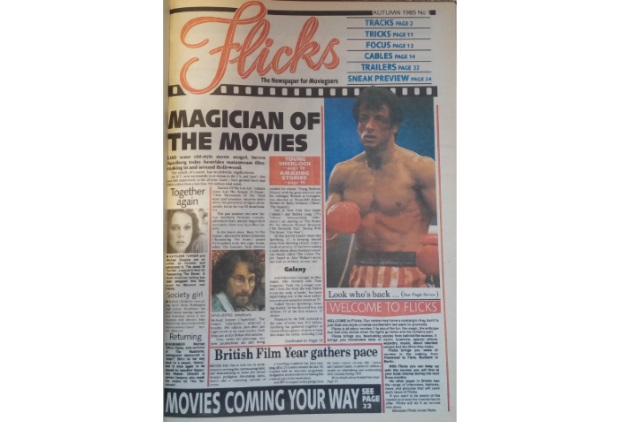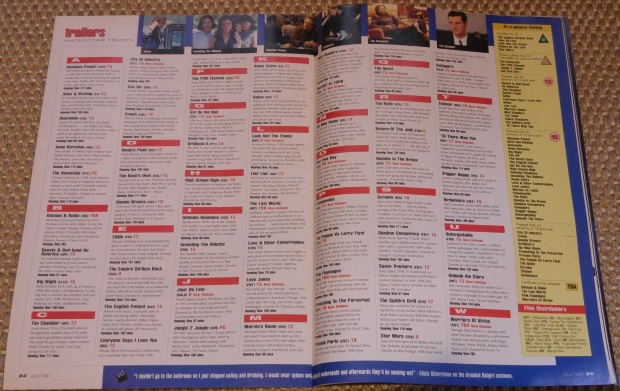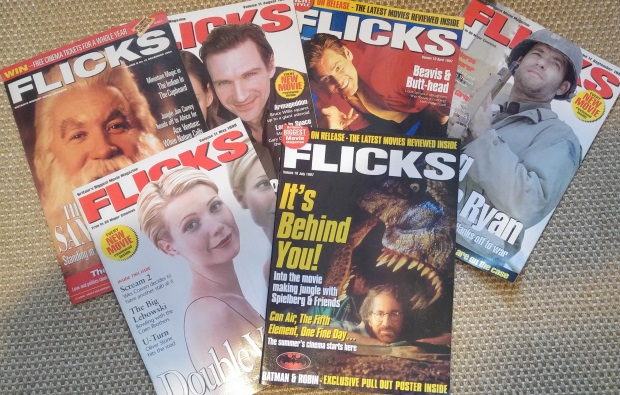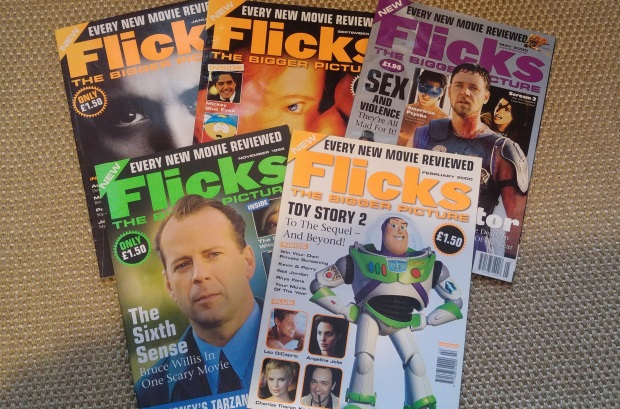Looking back at Flicks magazine
Flicks magazine used to be available free of charge at cinemas across the land. One of its former employees tells its story...
This article comes from Den of Geek UK.
If you were growing up in the late 1980s and early 1990s, your cinema-going ritual was written in stone. Tickets were bought face-to-face in the foyer after queuing outside (sometimes for hours). You grabbed your wine gums, Maltesers and butterscotch from the concession stand (popcorn? What’s that?). You took your (unreserved) seat in the non-smoking section and settled down to wait for the pa-pah pa-pah PA-PAH of the Pearl & Dean ads ahead of a promo film for a local Indian restaurant and Kia-ora’s latest attempt to flog you a glow-in-the-dark blend of E-numbers and sugar.
Oh, and you always – always! – had your free copy of Flicks clutched in your hand.
Free copy of what now?
It’s just a fond memory these days, but for 15 years, Flicks was a cinema-going staple in the UK. A free newspaper, then magazine, distributed in cinema foyers, it previewed new releases, featured set-reports and interviews, threw out snippets of behind-the-scenes news and gossip, and had some occasionally quite bizarre competitions (did you know that the Wycombe Six multiplex in, er, High Wycombe was named by a Flicks competition winner? You do now).
It all began in late 1984 when newspaper film critic Quentin Falk was tasked by a film industry marketing man named Gerry Lewis (no, not that one…) with producing a promotional giveaway aimed to try and help reverse the then-flagging fortunes of Britain’s sparkly new multiplexes. “Cinema admissions were at an all-time low,” Falk explained. With cash coming from both the film exhibitors (the cinemas themselves) and the distributors (the companies behind the films), they wanted to try various things to perk up the moviegoing experience, and one of those things was a newspaper that would promote all things cinema.

“I suppose it was advertorial,” muses Falk, “but the film companies never really interfered that much. My brief was to provide ‘optimistic previews’ and that’s what we did.”
With the help of a freelance designer and a freelance sub-editor working from home (Flicks at that time had no real fixed abode; it would be a few years before it acquired an office of its own), Falk put together a publication aimed at both the casual cinemagoer and the dedicated film buff. The features and interviews came courtesy of a regular roster of writers ranging from staffers on national papers (most using pseudonyms so that their bosses didn’t find out they were moonlighting) to hard-working lifers on the freelance circuit like Marianne Gray and the late, great Anwar Brett, a wry pros’ pro capable of turning around vast amounts of smart, informed copy in jaw-droppingly little time.
In Autumn 1985 the first issue, with Sylvester Stallone in full Rocky IV regalia glaring out of page one, arrived in cinemas. A million copies were printed. To put that into perspective, Empire magazine – the world’s biggest selling film publication – has never nudged over 200,000 copies a month at its print peak. Flicks – aided, of course, by a non-existent cover price – was an instant and undeniable hit and it’s not difficult to see why. Anyone hungry for film news and trivia in the mid 1980s faced lean times. Sure, you could stay up late to catch Barry Norman on the telly on Film 85, but otherwise the media offered slim pickings. The existing film mags of the 80s (Empire was still four years away from launch and Total Film wasn’t even a glint in Future Publishing’s eyes) were a stodgy lot more concerned with critical analysis than casting stories or tales from the set, and film coverage in national newspapers was patchy to say the least.

Flicks‘ trailers section alone – offering cast and plot breakdowns for all the movies due out in the next few months – was enough to make it indispensable to movie nerds in a pre-internet era. I can’t have been the only geek who took that home to circle the upcoming films I definitely didn’t want to miss, can I?
Originally released quarterly, it soon became clear that there was enough demand for Flicks to go monthly. And in October 1988 it ditched its smeary newsprint format in favour of a glossy magazine look, kicking off with Jamie Lee Curtis and John Cleese on a cover dedicated to A Fish Called Wanda. The print run had to drop slightly – shiny paper doesn’t come cheap – but the new format magazine was still punting out skywards of 750,000 copies every four weeks.
The demands of doing a monthly magazine meant that the team gradually grew. Quentin remained editor, but he was joined by a smattering of other staff over the years. By the magazine’s 10th anniversary in 1995, it not only had a permanent office in Fulham, but a full-time art director (Mike Rowney), an editorial assistant (Sarah Drew) and a brand-new sub-editor (me, starting my first job in film journalism).
We also had a new logo for the first time. The swirly neon font that had graced the cover for a decade hit the bin and a sharp sans serif number took its place. My nervy 20-something self didn’t have the guts to say it at the time, but I was rather sorry to see it go.

Also biting the dust over the next few years was Flicks‘ resolutely uncritical tone. We slowly introduced ‘proper’ reviews into the magazine – virtually nothing got less than a three star review, of course, we weren’t insane, as the film companies still paid our wages – but it gave things a bit more edge.
Flicks continued to ride high for a few more years – more staff joined, from a digital team (Sarah Fisher) to assorted in-house ad salesfolk – but there were growing grumbles from the industry, not least because the different cinema chains were starting to want their own individual magazines instead of a single umbrella one. We tinkered with rebranding issues with their logos on the cover, but it never quite satisfied them. Advertising revenues started to drop as film companies decided that perhaps their money would be better spent placing ads somewhere where people who weren’t already in a cinema would be able to see them.
To make up the difference, a plan was hatched to turn the magazine into a paid-for title, but the numbers never quite added up. Least of all for me – I was deputy editor when I left Flicks at the start of 1999, wishing them well, but not optimistic for their future.
Unfortunately, it turned out that I was right. Newsagents who already had Empire, Total Film and Sight & Sound were reluctant to give Flicks any of their limited shelf space too. Meanwhile cinemas, in whose foyers Flicks had always found a warm welcome, suddenly turned cold. Some were now producing their own free titles, while those that weren’t didn’t really know how to display or market the new £1.50 Flicks. And had little incentive to do so.

And the cinemagoers themselves? Well, they really didn’t take to the idea of paying for something that they’d always gotten for free. Especially when there was now a fast-growing thing called the internet offering a lot of the same info for nowt.
Sales tumbled. And in the words of Flicks‘ final editor, Jamie Graham (Quentin Falk had moved over to become Contributing Editor a few years before), “they were losing money hand over fist.” A few other publishing companies showed flickering interest in buying the mag, but no deals were ever struck and the magazine shut down suddenly in late 2000. “And poof, it was gone,” was Graham’s bittersweet summation of Flicks‘ final days. The last ever cover – not that anyone knew it that the time – was dated October 2000.
It went out with a whimper rather than a bang, but Flicks’ impact was still huge. It added something extra to the experience of going to the cinema. For a decade and more, ‘Britain’s Biggest Movie Magazine’ was simply always there. On family trips and date nights, Wednesday matinees and Saturday night blowouts, art-house outings and blockbuster opening nights alike, you could always pick up a copy in any cinema in any part of the country. In his opening column to the first-ever issue, Quentin Falk summed up what going to the pictures should be like, talking about “the fun, the magic, the anticipation that only comes when the lights go down and the curtains part.”
And for a generation of cinemagoers? Flicks played a big part in that.
